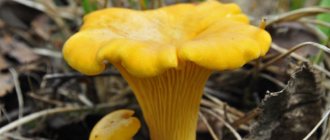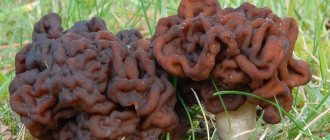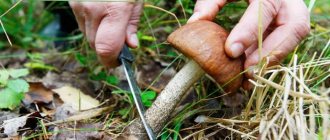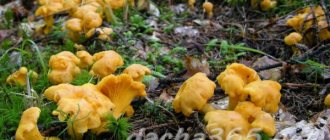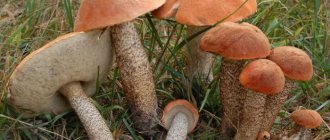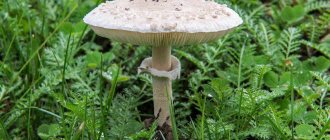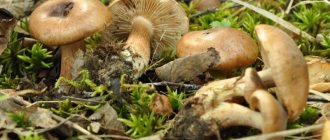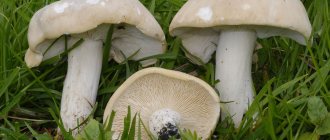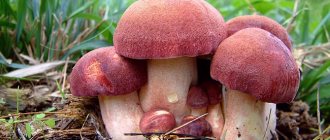The mushroom picking season has already begun in almost all regions of Russia and thousands of mushroom pickers have gone into the forest for a new “wild” harvest. Unfortunately, some of these people can become seriously poisoned due to their own carelessness or inexperience. To prevent this from happening, you need to be able to distinguish edible mushrooms from inedible ones. This can be done based on a number of external signs of the fungus. Of course, each species has its own differences, but there are also common characteristics of poisonous and inedible mushrooms.
Types of mushrooms
Mushrooms are divided into:
- edible;
- inedible;
- conditionally edible.
Edible mushrooms, photo and name, and description, of course, will help you decide when identifying a valuable food product rich in proteins and vitamins, minerals and aromatics. The number of edible mushrooms reaches 500 species, but no more than 100 species are known to a wide circle, and no more than 10-15 are known to most mushroom pickers. Great lovers and connoisseurs of mushrooms will always help a beginner understand their findings, but one should not trust them completely; mistakes are human.
How not to confuse the porcini mushroom.
Therefore, by carefully looking at the photo and remembering exactly what the most common and valuable mushrooms look like, you can easily and independently decide on the edibility of a mushroom.
The benefits of mushrooms for humans
Many types of mushrooms have a high content of vitamins and minerals. Thanks to this, they are very healthy and nutritious. And since there are many types of edible mushrooms in nature, they are a delicious dish, common in almost all countries of the world. Moreover, in many countries they even engage in industrial cultivation of mushrooms, which is an excellent solution, given their beneficial properties. This is their main use - eating.
.
It is also worth noting that mushrooms are often used for medicinal purposes.
: for the treatment or manufacture of certain medicines (the same antibiotics, for example). This happens because some types of mushrooms have unique properties or contain a large amount of extremely useful substances.
Well, mushrooms are also quite often used in the chemical industry and for technical purposes (production of citric acid, for example). Although this is not particularly important, since the industry could find a replacement for them. But finding food with such a high content of minerals is quite difficult. Therefore, first of all, mushrooms are valued as extremely healthy food.
What are poisonous mushrooms
Dangerous poisonous mushrooms are distinguished by the presence of toxins, and known poisonous components are represented by three main groups:
- The first group includes local toxins that can cause various disorders in the digestive system. This category includes species represented by russula, satanic mushroom, undercooked autumn honey mushrooms, variegated and yellow-skinned champignon, false puffball and tiger row. In rare cases, death may occur;
- The second group includes neurotropic toxins that have a pronounced effect on the human nervous system. The first symptoms of poisoning appear after about half an hour and can include hallucinations, loss of consciousness and severe indigestion. The group includes fly agarics, some types of fibers, talkers, rows, Russula vomitus, some hebeloms and entoloms;
- The third group includes toxins that have a pronounced plasmatoxic effect. This group of poisonous mushrooms includes stitches and many lobes, fringed galerina, and orange-red cobweb.
If the mushroom is highly poisonous, then even timely treatment cannot guarantee complete safety.
Interesting read: .
Why you can’t destroy poisonous mushrooms
The destruction of fungi can cause significant harm to the ecosystem and upset the natural balance. Many spongy and lamellar species that are poisonous to humans are used for medicinal purposes by some large artiodactyls. Also, poisonous varieties find purely practical use. Medicines and healing agents based on them can cure rheumatism, various nervous disorders, lung diseases and oncology, as well as many other pathologies.
Poisonous mushrooms.
General differences between edible and inedible mushrooms
Sometimes poisoning occurs due to one piece of toadstool or red fly agaric that gets on the table along with edible mushrooms. In order not to confuse edible and inedible mushrooms, it is necessary to accurately understand which specimens are common in the area and what they look like. Only the mushroom that is well known is placed in the basket. Some varieties of edible and inedible crops are similar to each other. Despite the similarities, they also have a number of differences.
- Appearance: the color of edible specimens is often dull, but there are exceptions. For example, the chicken mushroom has a bright yellow cap. The poison in inedible organisms repels insects. Edible specimens most often contain a lot of worms and beetles. Edible varieties also have a skirt. Most poisonous ones do not have it.
- Discoloration at the break (cut): edible and poisonous mushrooms are characterized by this feature. In edible specimens it becomes beige or brown, while in poisonous specimens it acquires a brighter color (red, orange), or the dangerous mushroom turns blue.
- Smell: This is often what determines edibility. Almost all edible mushrooms have a pleasant aroma. Parasitic mushrooms and specimens not suitable for food have a chlorine or medicinal odor, but there are exceptions (fly agaric).
- Cap surface: Many inedible varieties have a sticky cap that feels sticky to the touch. It is also worth avoiding those specimens that do not have a tubular layer under the cap.
- Base of the leg: in poisonous specimens, the base of the leg is almost always immersed (surrounded) by a special sac (volva) - a remnant of the common veil. Edible mushrooms do not have such a formation. Also, in inedible and poisonous specimens, in addition to the volva, the base of the stalk is expanded into a tuber-like well-defined formation.
These are the main differences between edible and inedible mushrooms. Of the poisonous species in Russia, the most common are the pale toadstool (green fly agaric), red fly agaric, thin pig and satanic mushroom. The pale grebe is deadly. If the above signs are absent, but you are not sure that the specimen found does not contain toxic substances, you should not take it.
Fly agaric.
What types of mushrooms are there?
Mushrooms are divided into edible, conditionally edible and inedible. The table shows the names of mushrooms of three groups.
| Characteristics of mushrooms | Name of mushrooms |
| Edible | White |
| Boletus | |
| boletus | |
| Dubovik | |
| Champignon | |
| Oiler | |
| Russula | |
| Morel | |
| Chanterelle | |
| Honey fungus summer, autumn | |
| Oyster mushroom | |
| Conditionally edible | Rows |
| Umbrella | |
| Pig | |
| Deer horns | |
| Gruzd | |
| Volnushki | |
| Line | |
| Inedible | Gall |
| Fly agarics | |
| Toadstools | |
| False honey fungus | |
| False fox | |
| False champignon | |
| Satanic |
Myths and folk signs about mushrooms
Many mushroom lovers have to be content with only purchased ones, since not everyone knows how to identify poisonous specimens and distinguish them from edible ones. Of course, banal logic will not allow you to cut off an acid-green specimen into a lilac speck, but many poisonous species look like they are quite edible.
Moreover, there are a lot of misconceptions about how to test mushrooms for toxicity. To refute most of them, experts say that there are no simple ways to determine the toxicity of a mushroom. Many species react differently to the same techniques, and it is very easy to become poisoned by a seemingly edible product.
A young mushroom does not mean it is edible
It is believed that all mushrooms can be eaten while they are young. It is implied that the poison in them appears only over time. This is also an absurd fallacy. For example, the pale grebe is poisonous at any age. It is best to study the mushroom encyclopedia and know the edible species by sight. If you have the slightest doubt about the suitability of a foundling as food, you should throw it away. This is not a case where the risk can be justified.
Phalloidin is one of the most dangerous mushroom poisons. Most of all it is contained in the pale toadstool. In terms of its adverse effects on the human body, phalloidin is equivalent to snake venom. An adult toadstool contains 10 mg of this substance, and when a person consumes 20 mg, 98% of cases result in death.
Will silver help?
There is a misconception: if you put a silver object in water during cooking, it will turn black, indicating that among the products there are poisonous ones. Amino acids that contain sulfur cause blackening of silver. But this substance is present not only in poisonous, but also in edible species. There is even a separate subspecies of poisonous mushrooms that this method will not detect. It follows from this that this method is not at all valuable.
How to determine if a mushroom is edible.
Onion and garlic
While cooking the mushrooms, add onion or garlic to the water. If there are poisonous mushrooms in the container, the heads of the root crops will turn black. It is useless to check the toxicity of mushrooms with onions or garlic during cooking. The color change of onion or garlic to brown during cooking occurs due to the pigment tyrosinase. It is found in both poisonous and edible mushrooms.
Boiling
If you boil fresh mushrooms for several hours, they will lose all their toxicity. Unfortunately, this is not the case - most of the poisons in mushrooms are heat-resistant and are not afraid of heat treatment.
How to pick mushrooms correctly.
sour milk
If you place mushrooms in fresh homemade milk for a while, it will turn sour. Enzymes such as pepsin and organic acids contribute to the sourness of milk. These enzymes are found in edible, inedible and poisonous mushrooms.
Bad smell
Poisonous mushrooms have a strong, unpleasant odor. Odor is an integral part of any mushroom. Only novice mushroom pickers will believe that poisonous mushrooms have a specific vile odor, while edible ones smell acceptable. This argument is not worth a penny. For example, champignon smells exactly the same as the terribly poisonous toadstool. In addition, not all people have a keen sense of smell and are generally able to distinguish the subtleties of mushroom aromas.
Pests
Worms, insects and snails do not eat poisonous mushrooms. If there are traces on the mushroom indicating that some small forest dweller has already feasted on it, then it is edible. This is another tale that circulates among beginners. Larvae, insects, snails and other small animals can spoil the poisonous mushroom with their appetite. Chanterelles and Polish mushrooms remain untouchable.
Alcohol is not a cure for poison
This is one of the most dangerous misconceptions. A high-proof drink will not help, but will greatly aggravate the condition of the person who has eaten poisonous mushrooms. Alcohol-containing substances provoke an accelerated spread of toxic substances throughout the human body, and therefore only accelerate the effect of the poison.
How not to get poisoned by mushrooms.
Pleasant taste
If a mushroom is tasty, it is not poisonous. Many mushroom pickers try raw mushrooms when picking. If it tastes bitter, it is poisonous. It is believed that the minimum amount of poison that enters the body with saliva during tasting will not cause significant harm. Reality: there are clearly poisonous mushrooms without bitterness with a very pleasant taste:
- death cap;
- poisonous entoloma;
- red and panther fly agarics;
- many other types.
Pink records
Pink plates under the cap of the mushroom indicate its edibility. Reality: indeed, young champignons also have pink plates, just like poisonous mushrooms, so this is far from an indicator.
Pink plates of mushroom.
Terrain
Poisonous mushrooms do not grow in open areas, but only in forests. Reality: A completely unfounded misconception. There are numerous cases of poisoning from mushrooms collected in meadows.
Fault color
When the cap is broken, the blue, pink or reddened flesh symbolizes the unfavorability of the find. White, gray, beige and other shades that have not reacted to the oxygen of the pulp indicate edibility. At the break, many edible species turn blue or change color.
There are certain varieties of mushrooms that are partially unsuitable. They need to be boiled for a long time in a special mixture of vinegar and salt, and then when fried they will be completely edible. But this method does not apply to all unfavorable samples.
Misconceptions about recognizing edible and poisonous mushrooms
There are many folk signs that supposedly can help in identifying poisonous mushrooms, however, many of them are wrong. Here are some of them:
- It is believed that the poisonous fruits have a very unpleasant taste. This is not true, fly agarics have a pleasant taste. And you shouldn’t carry out such experiments, because they can lead to severe poisoning. It is necessary to learn to recognize mushrooms solely by their appearance.
- Young poisonous mushrooms are not dangerous, but the poison accumulates with age. This is also not true; young specimens are no less dangerous, especially for pale grebes.
- Dangerous mushrooms have an unpleasant odor. This is only partially true, but there are entire categories that have a pleasant aroma or almost no smell.
In some cases, you can identify a poisonous mushroom by smell.
Picking mushrooms is a very delicate matter that requires serious preparation, otherwise you may end up in the hospital with a gastrointestinal disorder. Therefore, you should carefully study the differences between harmful and dangerous mushrooms. Even experienced mushroom pickers can make mistakes, but they will not put an unknown and dubious mushroom in the basket.
How do you distinguish edible mushrooms from inedible ones? Share your experience with newcomers in the comments.
Poisonous mushrooms in Russian forests
The mortality rate from poisoning with poisonous mushrooms reaches 90% in some cases! Poisonous mushrooms are especially dangerous for children. The main distinguishing feature of poisonous mushrooms is the presence of deadly substances in them, and not external similarity or the absence of any “normal” mushroom characteristic. Therefore, when going on a mushroom hunt, it is important to become thoroughly familiar with the representatives of poisonous mushrooms.
Poisonous mushrooms of Russia.
Death cap
Pale toadstool is perhaps the most poisonous mushroom! It is better to avoid poisoning with toadstool! The appearance of this mushroom is practically not much different from other mushrooms growing in forests, so it can easily be confused with an edible mushroom. The color of the cap of this toadstool is yellowish-brown, pale greenish or greenish-olive. Usually the center of the cap is darker in color than its edges.
The structure of this type of mushroom is quite fleshy, with cylindrical stripes of pale green color. On top of the leg there is a ring of striped pale or white color. Pale grebe (photo) forms mycorrhiza on deciduous trees, growing in mixed and deciduous forests. It begins to bear fruit at the end of summer to the end of September. Toadstool (pictures) is highly toxic.
Death cap.
False honey agaric
The mushroom has a convex cap up to 5 cm in diameter. The color of the cap is predominantly yellowish with a red or orange tint and a darker color in the center. The mushroom has a thin, smooth, hollow, fibrous stem. The flesh of the mushroom is light yellow, has a bitter taste and an unpleasant odor. The false honey fungus lives from June to October. Most often it can be found in fairly large groups on rotting wood.
The mushroom is poisonous and causes digestive upset. After 1-6 hours, signs of poisoning immediately appear: vomiting, loss of consciousness, nausea, excessive sweating. The false honey fungus is similar in appearance to the autumn, winter, summer and gray-plate honey fungus.
False chanterelle (orange talker)
This poisonous mushroom has a brightly colored cap from orange-red to copper-red. The shape of the false chanterelle's cap resembles a funnel with a smooth edge. The plates of the mushroom are bright red, sinuous. The stalk is approximately 10 cm long and 10 mm wide, often narrowed towards the base. False chanterelles mainly grow in the warm season from July to October, near real chanterelles. Also, this type of mushroom often grows in families, in rare cases alone.
Hygrophoropsis aurantiaca.
The false chanterelle can be easily distinguished from the edible chanterelle: The real chanterelle has a bright yellow color, a concave cap, smooth on top and wavy at the edges. The leg is dense and elastic, slightly darker than the cap. A characteristic feature of chanterelles is their pleasant fruity aroma. False relatives of the chanterelle are brighter in appearance, yellow-orange in color, with a hollow and thin leg. The edges of her hat are smooth, unlike a real chanterelle. And most importantly: the pulp of the false chanterelle has a very unpleasant odor.
Bile mushroom
These mushrooms are sometimes quite similar in appearance to edible mushrooms, and the first on this list of masters of camouflage is the gall mushroom or bitterling. Even a couple of grams of this mushroom can spoil a barrel of pickled edible mushrooms; all of them, as if by magic, will become bitter. The gall mushroom is similar to the king of mushrooms - porcini or boletus, but what should immediately catch your eye is the pink surface of the tubular layer, atypical for these edible mushrooms, the pink flesh and the brown, and not white, mesh on the stalk, which is not typical for these edible mushrooms.
Gall mushroom.
Red champignon
The second place is rightfully occupied by the red champignon. It has most of the characteristics of an edible mushroom, however it is highly poisonous. External differences that should definitely catch your eye are the yellowing of the fungal tissue on the breaks and an unpleasant odor reminiscent of carbolic acid.
False foam
Confidently in third place. This is one of the few types of inedible mushrooms. The mushroom can be quite easily distinguished by the color of the cap plates - at a young age they are sulfur-yellow, and over time they become greenish. The pulp of the mushroom itself has a bitter taste and should immediately raise suspicion.
False foam.
Fly agarics
The last place is occupied by mushrooms, which probably even a schoolboy can distinguish from edible ones - fly agarics. However, you should not think that fly agaric is always red. It can be white, as indicated above, and yellow, and green, and even brown. The cap of the fly agaric is spectacular, one might even say beautiful, it is covered with flakes characteristic only of this type of mushroom, and the leg below is noticeably widened and has a ring. The pulp of the mushroom smells so unpleasant that flies actually die from this smell.
The most common mushrooms are edible and inedible
The porcini mushroom, or boletus, is the best representative of the group of undoubtedly edible mushrooms of the first nutritional category. Although it has a fairly characteristic appearance that makes it easy to recognize, the boletus has an inedible twin - the gall mushroom or mustard. Edible porcini mushrooms can be identified by their thick cylindrical stem and reddish-brown cap. The flesh of the boletus always remains white, while the gall mushroom is distinguished by the fact that when broken, its flesh acquires a pink tint, and the mushroom itself is very bitter.
Red boletus is also a very popular edible forest mushroom among Russians. They have a dense brown-red cap. They can be easily distinguished from other mushrooms by their pulp, which quickly turns blue at the cut site. Despite the name, they can grow not only next to aspens, but also with other deciduous trees (never next to conifers). But for safety, it is better to collect such mushrooms only under aspen and poplar trees. However, it is quite difficult to confuse boletus with other mushrooms, since it does not have false doubles.
Maslyata are very loved and popular in Russia. They can be recognized by the yellow color of the stem, and the cap is covered with a sticky brown skin that can be easily removed with a knife. Under the cap is a characteristic tubular structure. As a rule, when they talk about edible tubular mushrooms, they mean butter mushrooms. Adult mushrooms are almost always rich in worms, which is also a good sign.
Chanterelles have a rather unusual appearance. Appearance is an evolutionarily established set of individuals, characterized by a single ..., by which they can be easily identified among other edible mushrooms in the forest. However, they have a very similar double, which you identify by a more saturated orange hue (the edible mushroom is lighter), a hollow stalk (the real one is dense and solid) and white discharge on the broken cap.
Honey mushrooms are edible mushrooms known for their characteristic rich taste. Since in fact, several types of mushrooms are called honey mushrooms at once, it is sometimes difficult to give them a single description. For safety, it is recommended to collect only those honey mushrooms that grow exclusively in the roots, on stumps and on fallen trunks. They have ocher-colored caps with scales on them and a white ring on the stem. False honey mushrooms are also several types of mushrooms. Honey mushrooms should be avoided if they grow on the ground; their cap is yellow or brownish-red and lacks scales. While the cap of real honey mushrooms is equipped with whitish plates, those of false honey mushrooms are olive, dark gray or brownish. Also, there is no ring on the leg of the honey fungus.
Russulas are widespread edible mushrooms in the middle zone. This name is used for several species at once, the differences of which from inedible relatives lie in the presence of easily removable skin on the caps.
How to distinguish edible mushrooms from false ones
It is very easy to confuse real honey mushrooms with false ones, since both types of mushrooms grow in groups in the same places - on stumps, fallen trees and protruding roots. The edible appearance of these wonderful mushrooms is distinguished from their numerous inedible “brothers” primarily by the “skirt” on the stem. It seems to connect the cap with the stem. Poisonous mushrooms do not have it. The hat also says a lot. Firstly, in real mushrooms it is lamellar. Secondly, edible honey mushrooms will have scales on their caps. In addition, false honey mushrooms often have an unpleasant odor and a brighter color.
How to perform a control check
In addition to the fact that you need to carefully select mushrooms in the forest, you should also check them when you arrive home. They cannot be stored raw, so they will have to be washed, peeled and cooked right away. It is during cleaning that a control check should be carried out and not only supposedly poisonous mushrooms should be excluded, but also old specimens that can also become dangerous.
The most proven way to determine edibility is a thorough visual inspection.
How to distinguish between false and edible boletus
The real ones, which can be eaten, have a slippery cap and the same leg. The skin on top is sticky, as if covered in oil (hence the name). This property is especially evident in wet weather. In dry weather the skin is glossy. It is easy to remove with a knife, while it stretches. The cap always has a spongy structure. As for color, it varies depending on the type of edible oilseed. Inedible types of butternut squash often change the color of the flesh at the break or cut (turns red, turns blue). In general, there are a large number of types of boletus, among which there are edible, inedible and conditionally edible.
Material on the topic: White milk mushroom and its doubles
Butterflies prefer pine and spruce forests, which have dry soil and little grass. They are easily confused with pepper mushroom. It is almost impossible to get poisoned by it, but it will ruin the entire dish. Edible butternut caps are sticky, as if smeared with oil, and the skin can be easily removed with a knife. There is a “skirt” on the leg. The pepper mushroom has a reddish tint to the stem and pulp, and a brown cap. The spongy layer is approaching dark, and there is also no “skirt” on the leg. False boletus also comes with a slightly purple colored cap.
How to distinguish between false and edible boletus.
Which method is the most reliable?
Here's what you should do to determine the fate of an unknown mushroom:
- Examine the inside of the cap and recognize its structure: lamellar or tubular. Most poisonous mushrooms are of the lamellar type.
- Inspect the lower part: harmful mushrooms very often have an ovoid-shaped thickening on the stem;
- Identify the presence of a collar ring, usually located in the middle of the stem, a little closer to the cap. Such an element may indicate the danger of the specimen.
Mushrooms with a ring on the stem are usually very poisonous
How to distinguish a forest champignon from a toadstool
This mushroom can be confused with the very poisonous toadstool. A real champignon has a dry, smooth or slightly scaly round cap, white or grayish in color. The plates under the cap darken when touched. In the pale grebe, the plates do not change color. In addition, the toadstool completely lacks a sac-like film at the base of the leg, which is characteristic of an edible champignon. And one more clear sign of difference - real champignons grow in open, well-lit places, on the edges or along forest roads, in swampy areas and even in the garden. And pale grebes love deciduous forests.
How to distinguish forest champignon from toadstool.
How does a mushroom work?
Most mushrooms have a well-defined stem and cap. On the lower surface of the cap, plates or a sponge are visible where the spores are contained. Spores spill out when ripe and are carried by the wind.
The most important part of the mushroom is the mycelium. These are peculiar roots that look like thin threads. Threads or hyphae penetrate the soil, collecting nutrients and moisture from a large area.
Many mushrooms prefer certain landscapes or tree species. Honey mushrooms and oyster mushrooms grow on rotten stumps, among the champignons there are meadow and forest varieties, oak mushrooms are found in oak forests, white mushrooms are found in coniferous forests.
Mushrooms combine the properties of plants and animals. Like animals that consume ready-made substances, the cells are strengthened with chitin. Like plants, they constantly grow, but cannot move, they reproduce by spores, and feed with the help of special organs.
How to distinguish russula
very unpretentious - they can be found in almost any area. Russulas have multi-colored caps - pink, red, yellow, brownish, greenish, always without spots or dots. The skin is easily removed from them, and the stem is white and easily broken. In poisonous counterparts, the flesh is denser and more elastic, has a pink color, there is a reddened or darkened soft film on the stem, and there are spots and dots on the cap. The main difference from normal russula is its unpleasant and bitter taste.
Interesting read: Chanterelle mushroom: where and how to collect it correctly
Report No. 4
Mushrooms are a special kingdom of living nature. They are distributed in all layers of the biosphere. Mushrooms are classified as a separate kingdom of the living environment because they have characteristics of both plants and animals, and their own special characteristics. Mushrooms reproduce by spores, just like ferns.
Edible mushrooms both grow in the forest and are grown by humans. Edible means that if you eat them, there is no harm to a person. There are several thousand species of them. Below, each of the edible mushrooms is presented in more detail.
For example, Roquefort is a type of cheese on which a person specially breeds blue mold for a unique taste.
The most famous edible mushroom is the summer honey fungus or linden honey fungus. The honey mushroom cap is from three to six centimeters in diameter, honey-golden or yellow-brown in color, matte. The pulp of the honey mushroom is thin and watery. The leg is very thin - up to a centimeter in diameter, up to seven centimeters high.
Many honey mushrooms can be found on rotten wood or damaged trees. Very common in deciduous, mixed and coniferous forests. In dry climates it is difficult to find linden mushrooms.
The poisonous mushrooms Galerina fringe and the inedible false honey mushrooms are very similar to honey mushrooms.
Champignons are very common and can be found in almost every store. They are very easy to confuse with toadstool - one of the most poisonous mushrooms. Champignons have pink flesh, slightly reddening, while toadstools have gray flesh.
The champignon cap is from three to eight centimeters in diameter. The leg is strong, from three to ten centimeters in height and three to four centimeters in width.
Everyone has heard about porcini mushrooms or boletus mushrooms. These are edible mushrooms with a white stalk and a brown or reddish-brown cap with a diameter of seven to thirty centimeters, sometimes the diameter reaches fifty centimeters.
Camelina mushrooms correspond to their name in appearance: they are yellow-pink or orange-red.
Saffron milk caps are very good for health, because they get their red color due to the content of vitamin A, B vitamins and ascorbic acid. They contain potassium, phosphorus, sodium salts, and fiber.
Milk mushrooms and russula are common throughout Russia. The diameter of the cap ranges from five to twenty centimeters. The skin is light, slimy and wet. The leg is up to seven centimeters high, smooth, white or yellowish. Found in deciduous and mixed forests.
It is worth remembering that even edible mushrooms, if improperly processed or stored, can cause serious harm to health, so the issue of preparing mushrooms must be approached responsibly.
2, 3, 5 grade, biology
What to do if you are poisoned by mushrooms
Symptoms of poisoning by improperly prepared conditionally edible mushrooms are as follows: nausea, vomiting, diarrhea a couple of hours after consumption. You can also be poisoned by completely edible mushrooms. Mushrooms should not be old, wormy, and already cut, dried or salted mushrooms should not be spoiled. At the first external signs of mushroom spoilage, it is better to stop using them. The place where the mushrooms were collected also matters. Growing along roads is not the best option.
When preserving mushrooms, it is important not to close the jar very tightly, tightly, with a lid or store it in a galvanized container. The main rule when picking mushrooms is: never take a mushroom unless you are sure it is edible. It is better not to put a couple of edible mushrooms in the basket than to take home one poisonous one and get poisoned.
Where and how to pick mushrooms with children
We give some tips on where to look for edible mushrooms and how to collect them correctly.
- The most mushroom-producing places are considered to be: gentle slopes, ravines, low and flat hillocks, sloping ridges, and dry groves.
- They go out to pick mushrooms early, when there is still dew. At this time, the caps shine and the mushrooms become more noticeable.
- Some mushrooms are harmed by cutting, so it is not necessary to take a knife to mushroom hunting - they can be picked or twisted. But it is much more ethical to cut the mushrooms at the root, rather than tear them out of the ground completely. So that new mushrooms will grow from the remaining mycelium next year.
- Mushrooms spoil quickly in closed containers and plastic bags. Therefore, when going for mushrooms, it is better to take a basket or any other open, “breathing” container.
- The best mushrooms are considered to be porcini mushrooms - boletus, boletus, boletus and saffron milk caps.
